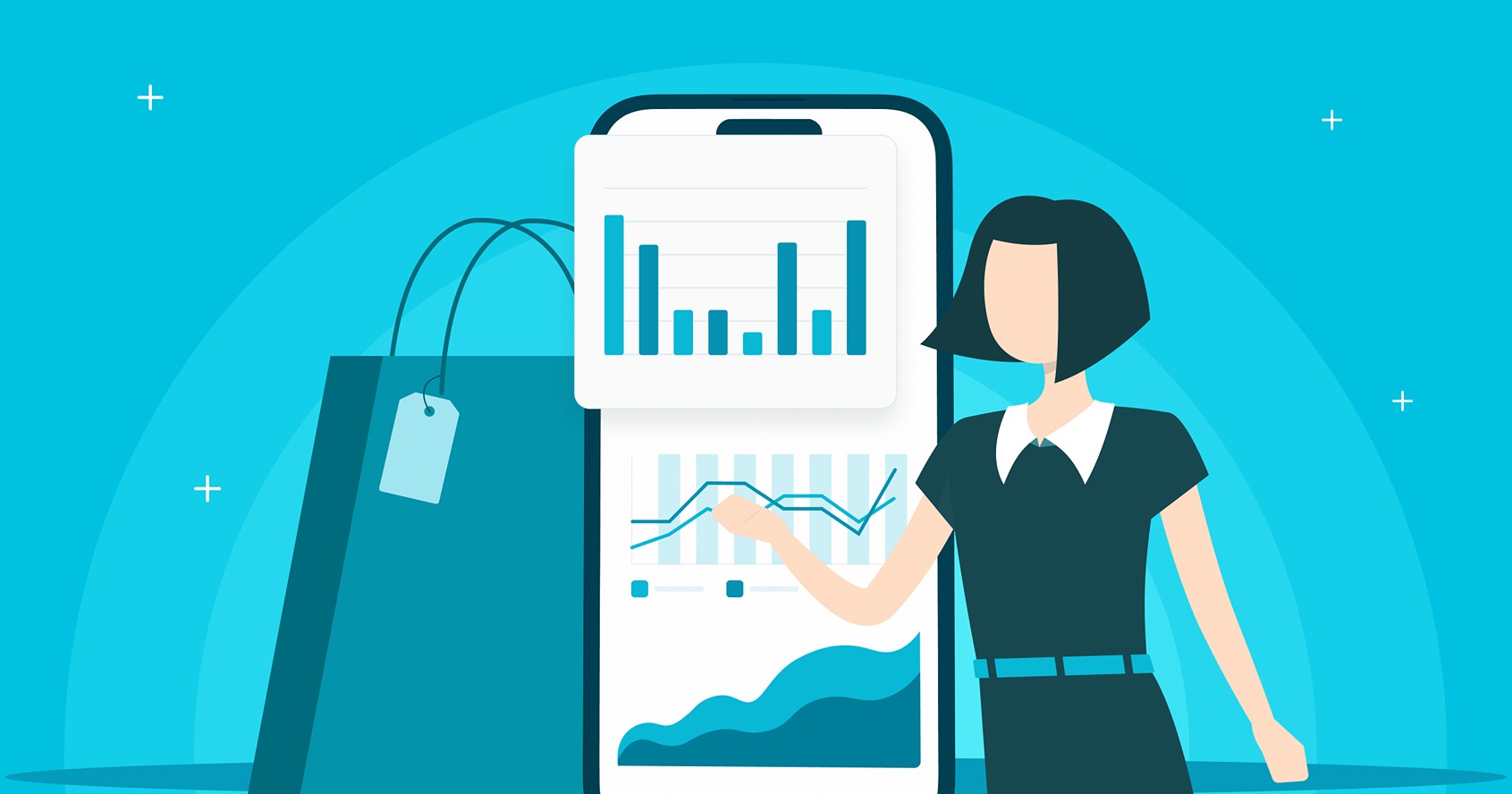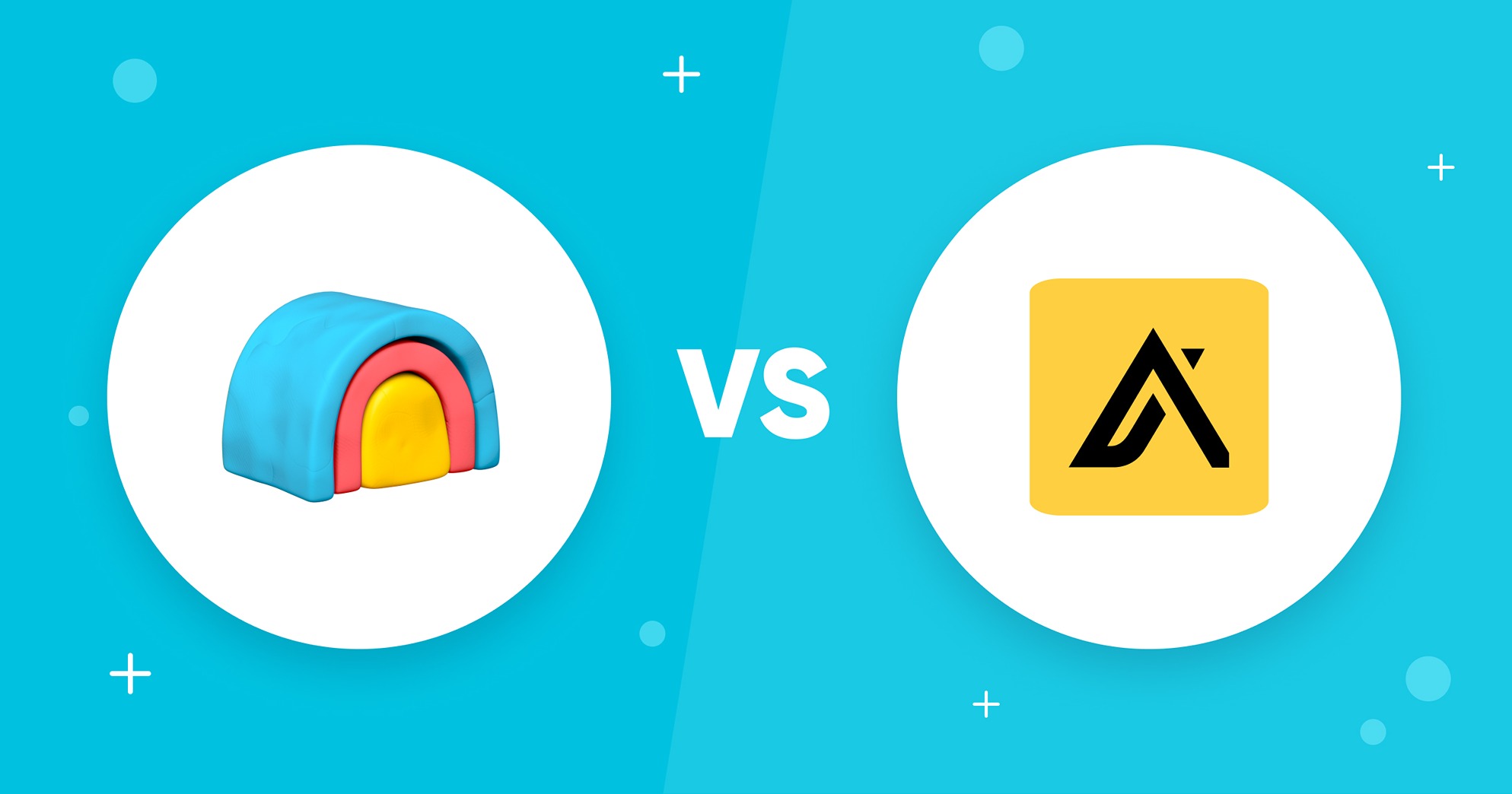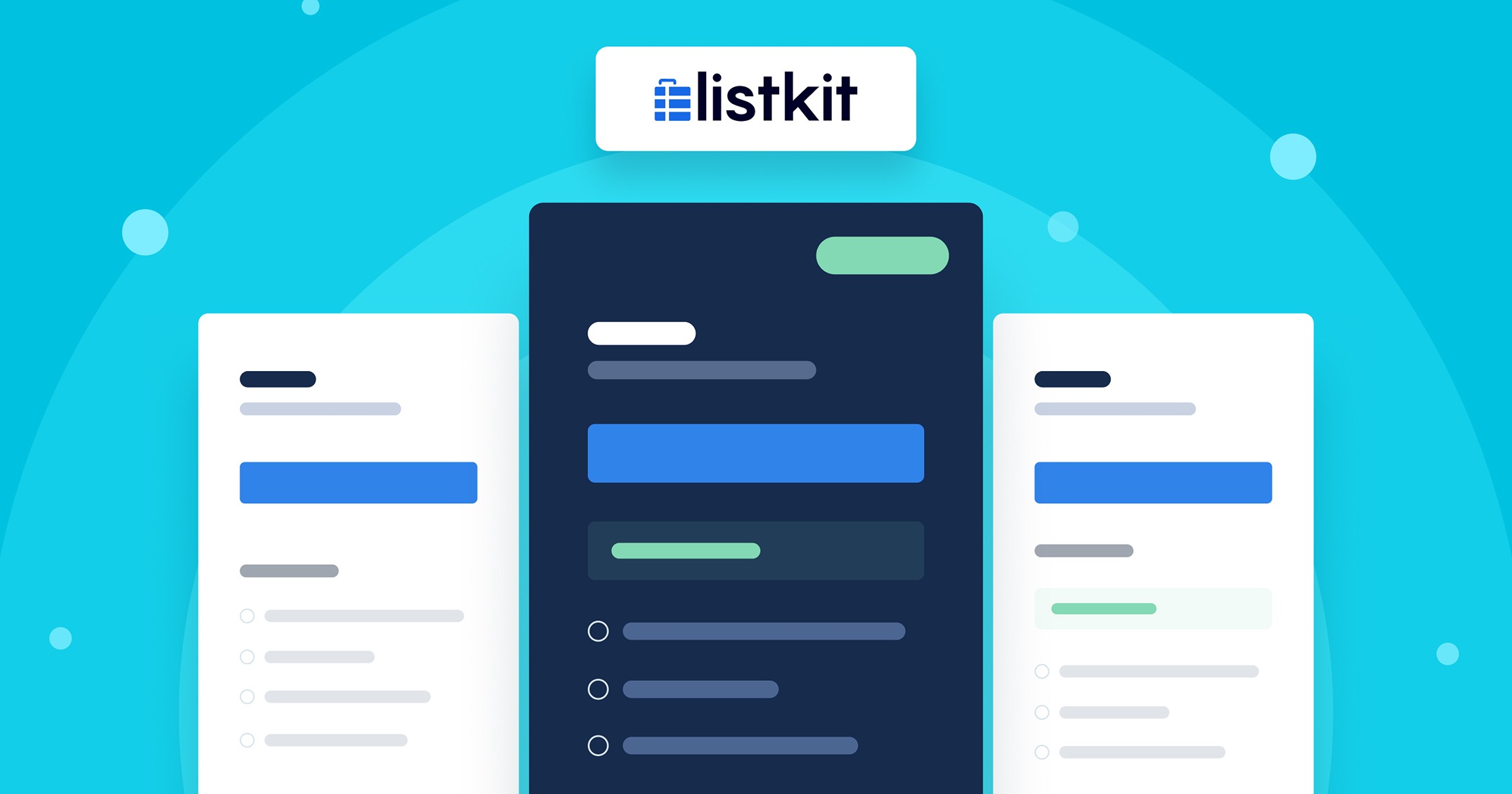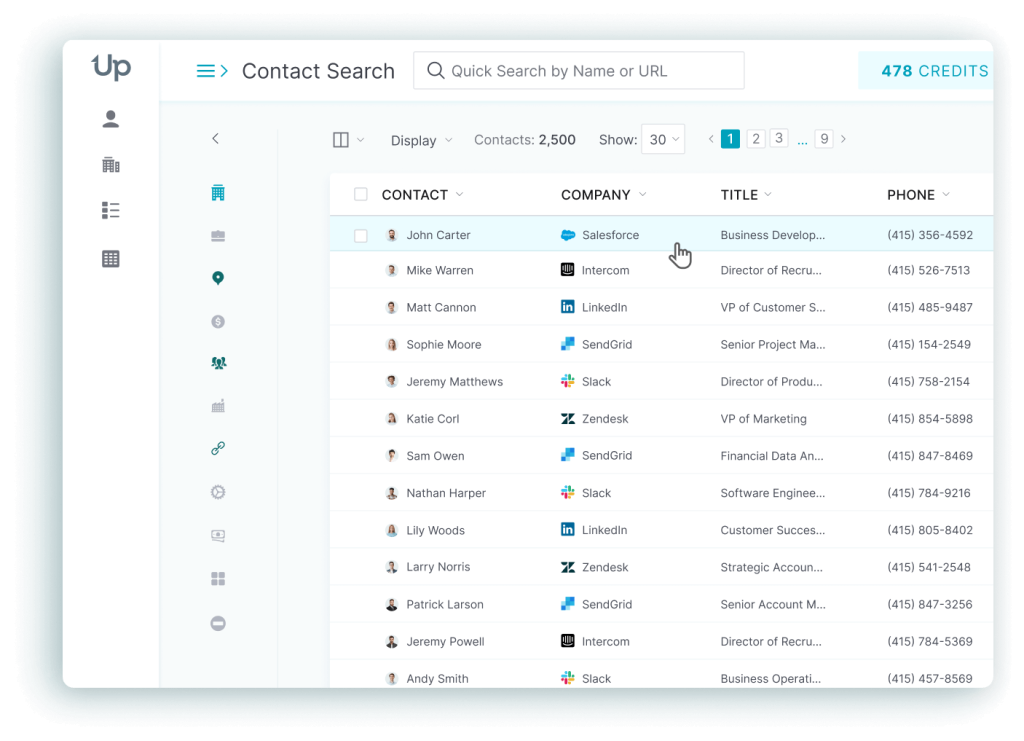Are your sales reps wasting time on prospects who aren’t ready to buy? Buyer intent data might be the answer. This data eliminates the guesswork of empty prospects by tracking specific digital behaviors that signal purchase readiness—like when a company visits your pricing page three times in a week, downloads competitor comparison guides, or spends 15 minutes reading case studies.
These aren’t vague “signals” but concrete actions that show a prospect is actively researching solutions. Analyzing these specific behaviors across multiple touchpoints allows you to identify which accounts are genuinely interested rather than just browsing.
Let’s explore how you can leverage buyer intent data for your B2B company, especially in a time when big data is only getting bigger. We’ll also explore multiple data providers and the key features offered by our B2B data platform, UpLead.
What is Buyer Intent Data?
Buyer intent data captures real, measurable actions your prospects take, indicating how likely they are to make a purchase. For example:
- Visiting your trial or demo page
- Reading detailed feature descriptions on your website
- Visiting your website multiple times
- Checking your pricing page
- Downloading a whitepaper
- Signing up for a webinar
- Reading a blog post
Keep in mind that not all actions communicate the same level of intent, and so each action carries a different conversion weight. For example, visiting a pricing page indicates a deeper funnel position than reading a blog.
Types of Intent Data
Businesses can leverage two main types of intent data: first-party and third-party. Both are valuable for marketing and sales, but their difference lies in how they’ve been collected.
First-Party Intent Data
First-party intent data is collected directly by your company through owned channels such as your website, customer relationship management (CRM) platform, or social media accounts. For example, when a VP of marketing downloads your pricing guide, spends four minutes on your case studies page, and returns three times in a week, you’ve captured valuable first-party intent data.
You know this data is accurate, as you’ve collected it yourself, and it’s particularly relevant because it comes from your own audience.
We can divide first-party intent data into two categories:
- Known: Prospects who’ve provided you with their name, email, company name, and/or job title (usually through forms or surveys).
- Anonymous: People who browse your content but haven’t personally identified themselves. You can track their IP address and behavior patterns but can’t connect them to an individual or company.
In terms of how data is collected, we can segment it based on different sources, such as:
- Website: Page-specific engagement metrics like scroll depth, time spent on page, or downloads of sales collateral.
- Social media: Quantifiable interactions such as poll responses, shares, saves, comments, and direct messages
- CRM: Data on lead behavior, email open rates, and past purchase history.
- Marketing automation software: Positive and negative email responses, webinar attendance, and content downloads.
- Sales interactions: Call recordings, meeting notes, demo requests, live chat conversations, and proposal submissions.
Inbox Insight’s internal research shows that 55% of companies collect a combination of first-party and third-party data, and yet the former is disproportionately prioritized when it comes to taking action. Companies rely on their own collected data because it directly reflects their audience’s interests and has no licensing costs. However, that doesn’t mean third-party data is inferior; if anything, it’s underappreciated and underutilized.
Third-Party Intent Data
Third-party intent data is gathered from sources outside your company. Data providers aggregate behavioral indicators across thousands of websites, forums, and other platforms to identify buying patterns. Because of the breadth of this data aggregation, it’s much easier to outsource and automate this work through third-party providers than to try and replicate it through first-party data.
However, third-party data provides broader industry insights rather than direct interactions with your brand. For example, it might tell you which companies are researching “marketing automation tools” broadly but not how they respond to your specific value proposition.
Third-party data comes from specific sources that reveal buying intent:
- Review sites: Information on reviews and ratings on platforms like G2 and Trustpilot.
- News articles: Identifying news in which decision-makers talk about new markets or technologies they’re interested in.
- Third-party data providers: Platforms like UpLead aggregate behavioral touchpoints like technology stack data or hiring trends from multiple sources.
4 Types of Buyer Intent Data Sources
Buyer intent data can be grouped into four different sources: search intent, engagement intent, firmographic data, and technographic data. When paired together, these create a holistic view of the company’s buyer intent.
1. Search Intent Data
Search intent data comes from two main sources: first-party tools like Google Search Console, which show the search queries that lead to your site, and third-party tools like Ahrefs, which use clickstream data. Clickstream data is collected from browser extensions and user panels that track browsing behavior, which can then be analyzed to reveal broader search patterns.
For example, suppose Google Search Console shows that people are finding your “Best Social Media Marketing Tools” page by searching for “what are the benefits of Sprout Social,” but your page barely mentions these benefits. In that case, you’ve identified a critical content gap to address.
By using search intent data to optimize existing content and create new material that directly answers what your prospects are actively searching for, you transform your website from what you think users want to know to what they’re actually looking for—making your content more relevant and valuable.
2. Engagement Data
When a prospect engages directly with your assets—let’s say they download your pricing guide, watch your demo video, and return to your features page thrice a week—they display purchase signals. Armed with this information, you can set up automated alerts to notify sales reps when prospects trigger predefined engagement thresholds so they can reach out while interest is high.
3. Firmographic Data
Firmographic data includes general company information, such as their size, revenue, and location.
Data providers like UpLead reveal companies that match your ideal customer profile—for instance, healthcare startups with 10-50 employees that raised funding in the last six months. You can filter prospect lists using these exact parameters to focus your outreach on companies that match your intended prospect profile..
4. Technographic Data
If you want to understand which type of software a business needs, technographic data is a key insight. This type of data includes information on the software stack your prospects are using.
For example, you could target companies running software that integrates seamlessly with your own. Alternatively, you could target companies using your competitor’s soon-to-sunset email platform, highlighting your one-click migration tool to future-proof their operations.
10 Ways to Use Buyer Intent Data
To understand the potential of buyer intent data, let’s dive into the actionable use cases for sales and marketing.
Intent Data for B2B Sales Teams
Intent data can improve your B2B sales approach in five significant ways.
1. Lead prioritization
Instead of pitching to hundreds of businesses in a certain industry, you can prioritize leads that have shown buyer intent in products similar to yours. This saves you time, as you won’t have to contact companies that may not be interested in a particular product.
For example, let’s say you have a database of hundreds of marketing agencies, and you want to pitch your automation software. You can prioritize leads interested in options like Zapier and Make.
With UpLead and its company search, you can easily select relevant technologies and only show companies that use that software.
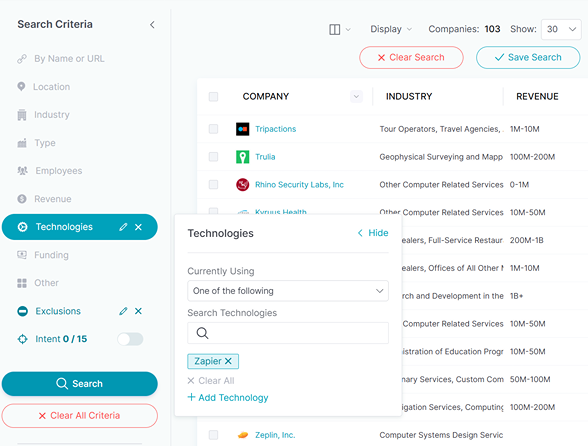
This way, you’ll contact prospects who likely want to automate tasks, opening the door for you to pitch your software.
2. Personalizing pitches
You don’t have to write generic pitches—and you shouldn’t, because savvy customers can always tell. Instead, if you know a business needs a tool with certain features, you can focus on that. For example, if you know that a business is looking for email marketing systems, leave out the generic introduction and start with what matters to them: your email marketing tool’s features.
Likewise, if a company has shown interest in sales tools, get right to that point. Don’t start with, “Hi, we’re a business that does X”. Instead, start with, “Our platform offers features including lead scoring, automated follow-ups, and real-time pipeline tracking”.
But how do you know if someone is interested in email marketing or sales tools?
In UpLead, you can use intent data as a search criteria to filter your company search.
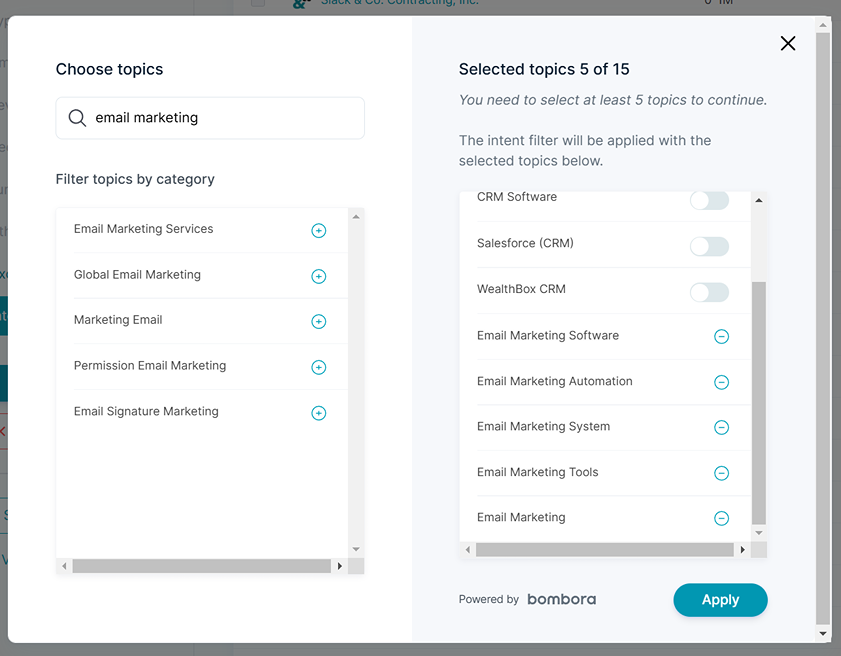
3. Re-engaging lost prospects
If you’ve already contacted a prospect who didn’t reply or denied the offer, they can be counted as a lost prospect. However, you can turn this to your advantage.
Let’s say you’ve contacted a business in the past to pitch them your email marketing software, and they either declined or didn’t reply.
After some time, your intent data shows they’re still looking into similar solutions. This suggests that their window of interest is still open, and you can then send them another pitch.
In UpLead, you can easily get intent data by going to Company Search, clicking on Intent, and choosing at least 5 suitable intent topics your leads should be interested in (in this example, email marketing services, email marketing software, email marketing automation, email marketing tools, and email marketing).

4. Shortening the sales cycle
Instead of nurturing leads still in the awareness phase, sales teams can focus on prospects who have demonstrated clear intent, such as signing up for a webinar or engaging with your pricing information.
By jumping in at the right moment with the right offer, you can reduce the time it takes from the initial interest to the final purchase because you know, based on intent data, that they’ve already considered making a purchase.
5. Competitive targeting
If, based on buyer intent data, a customer is exploring your competitors, you can swoop in and present your own offer. This pulls their attention away from competitors, and you can leverage your knowledge of competing companies to offer something better, such as a limited-time discount.
UpLead simplifies this process. Let’s say your solution is a competitor to Microsoft Teams. To get a list of companies interested in Microsoft Teams, you can go to Company Search, choose Microsoft Teams in Intent Topic, and filter your output based on that.
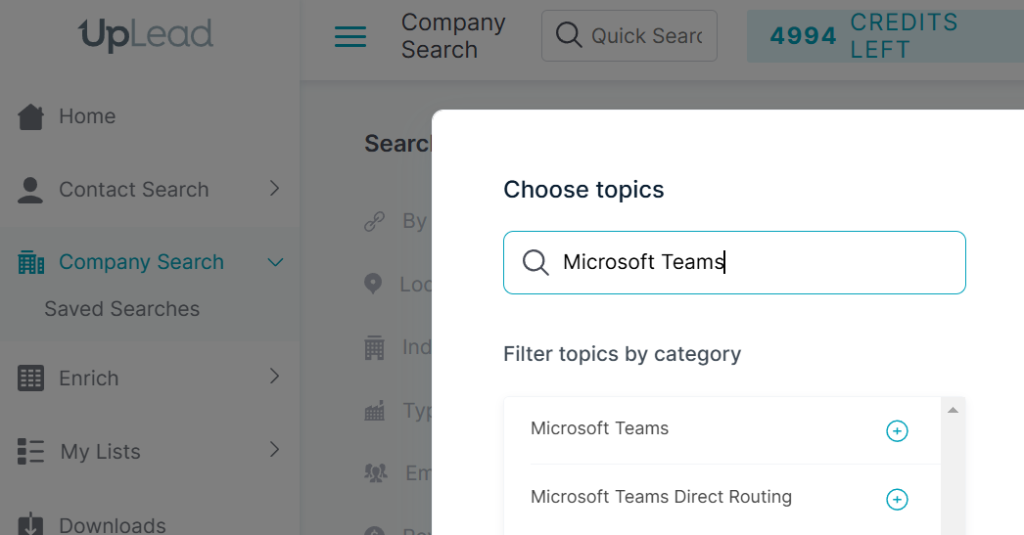
Intent Data for B2B Marketing Teams
Besides sales, intent data can help marketing teams make their campaigns more precise.
6. Account-based marketing (ABM)
Buyer intent data improves ABM strategies by helping marketers focus on accounts showing signs of interest in a product or service. Instead of broad, generalized campaigns, marketing teams can identify high-intent accounts that are actively researching solutions and tailor their outreach accordingly.
But — buzzwords aside — how can you practically find and connect with these high-intent accounts? The typical use case is not that abstract, and UpLead offers a simple filter through its UI.
For instance, you offer cybersecurity solutions. Go to UpLead’s Company Search, click on Intent, add topics related to cybersecurity (such as cybersecurity regulations or cybersecurity framework), and apply other relevant filters (like company size and key decision-maker roles).
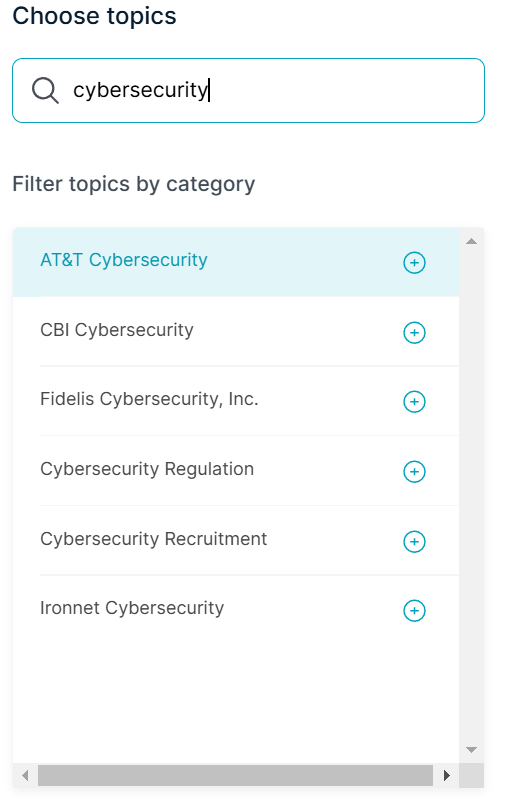
This way, you’ll generate a list of companies that match your criteria AND have recently engaged with cybersecurity content.
Now, you can pick the relevant decision-maker contacts on their UpLead company profile, add them to your outreach list, and send them a personalized email referencing their recent interest in cybersecurity and positioning your solution as the perfect fit for their challenges.
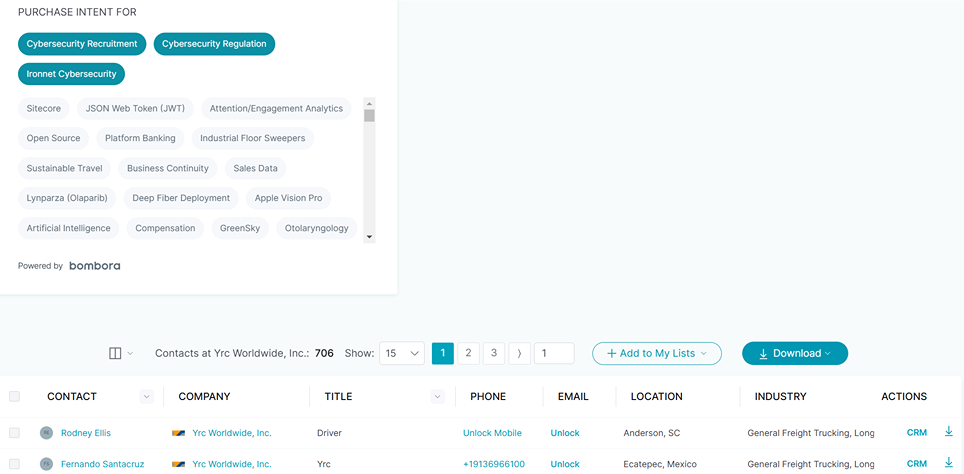
7. Retargeting campaigns
Similar to re-engaging lost prospects, retargeting campaigns aim to get potential buyers who have visited a website, downloaded a resource, or interacted with marketing content to convert. By using search intent and engagement data, you can create ads or SMM campaigns to keep your brand top-of-mind for potential buyers. These campaigns are highly effective for prospects in the decision-making stage, redirecting them back to your offerings.
Case in point: The Toronto-based bicycle retailer Myfix Cycles was barely breaking even with Google Ads until they implemented a Facebook retargeting campaign. By using the Facebook Pixel to track website visitors, Myfix Cycles segmented users based on their actions (such as adding products to their cart) and re-engaged them with personalized ads. This targeted approach delivered an impressive ROI%, generating approximately $15 for every $1 spent.
8. Event targeting
Industry events, trade shows, and webinars attract high-intent prospects actively seeking solutions. Buyer intent data can help you understand which prospects have visited these events. Then, your marketing or sales team can follow up with tailored outreach, offering exclusive post-event content, product demos, or special promotions to capitalize on their interest.
Better yet, most event organization platforms already collect this data and make it readily accessible. Tools like Eventbrite, LinkedIn Events, and industry association calendars can provide event participant lists. Additionally, by monitoring social media, you can see when prospects announce their attendance or participation at upcoming events through company posts or employee updates.
To gather participant information from third-party events, you can establish partnerships with event organizers who might share attendee lists in exchange for sponsorship or other agreements.
9. Content personalization
Instead of creating generic content for your prospects, buyer intent data can show which topics and products your customers are mainly interested in.
You can personalize your sales and marketing collateral to address the key pain points that prospects experience. To achieve this, you can create videos, whitepapers, blogs, or case studies.
UpLead makes this as simple as a search.
For sales enablement specifically, you can leverage UpLead’s intent data to create highly targeted content. Go to Company Search, select Intent, and choose topics your target accounts are engaging with. For instance, if you’re selling CRM software, search for companies showing interest in Data Driven Sales, Mobile CRM, or CRM Best Practices.
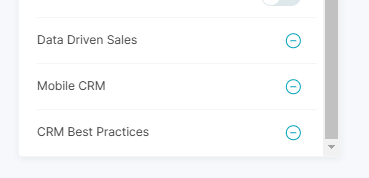
Once you’ve identified these companies, visit their UpLead profiles to understand details such as their industry, company size, and key decision-makers’ roles.
Now, create customized sales collateral for each segment. For example, if financial services companies are researching “CRM Best Practices,” develop content explicitly addressing how your CRM protects sensitive financial data.
Your sales team can then use these personalized resources during calls or follow-ups. When a rep contacts a prospect researching mobile CRM capabilities, they can immediately share your custom guide on “How Our Mobile CRM Increases Sales Team Productivity by 37%,” speaking directly to the prospect’s demonstrated interests.
According to SiriusDecisions, 82% of B2B decision-makers think sales reps are unprepared to answer their specific questions. By arming your sales team with intent-based personalized content, you can demonstrate impressive insight and dramatically increase your chances of conversion.
10. Email marketing optimization
Instead of sending the same emails to all leads, marketers can segment audiences based on their engagement levels, website interactions, and search intent. For instance:
- High-intent prospects: Can receive personalized sales offers or case studies. This includes companies actively seeking a solution and engaging with sales, such as by requesting demos or pricing details.
- Mid-intent prospects: Could be nurtured toward a decision through educational content. Mid-intent prospects can be companies researching solutions but not yet ready to buy, such as by downloading whitepapers or attending webinars.
- Low-intent prospects: Might be placed into a longer-term nurturing sequence with industry insights and brand-awareness content. These businesses are in the awareness stage, passively consuming content, such as by blog posts or following on social media.
By categorizing your prospects like this, you can meet them where they are and create content that they will find most useful in their journey.
Benefits of Leveraging Buyer Intent Data
If the use cases weren’t enough to convince you how important buyer intent data is, take a look at the key benefits below:
- Higher conversion rates: Without the right data, you might be targeting totally uninterested businesses. Since intent data shows which individuals from which companies are ready to make a purchase, contacting interested prospects leads to an increased chance of conversion.
- More efficient sales outreach: If you know which leads are highly engaged and interested, you can focus your sales efforts on them instead of those who aren’t interested or informed.
- Stronger personalization: By analyzing various facets of a company, such as its technology stack and search behavior, you can tailor your messaging more effectively. For example, technographic data reveals the tools a company is already using, while search intent data indicates the solutions they are actively researching. Using this information, you can cater your outreach to directly address their needs and pain points.
- Better ROI on marketing campaigns: By reducing the time and effort spent on audiences with low engagement and intent, you can get more out of your marketing campaigns. DemandScience research points out that 78% of B2B teams are confident that intent data will deliver a good ROI, underscoring the importance of this data’s insights for your campaigns.
- Improved competitive positioning: If you understand which competitors a prospect is exploring, you can “steal” the customer by offering competitive pricing or exclusive deals, swaying them at the right time. For example, you can provide them with a yearly discount or a feature that is normally included in more expensive pricing tiers.
Best Buyer Intent Data Tools
To help you find the right intent data provider, we’ve compared some of the best options on the market.
1. UpLead
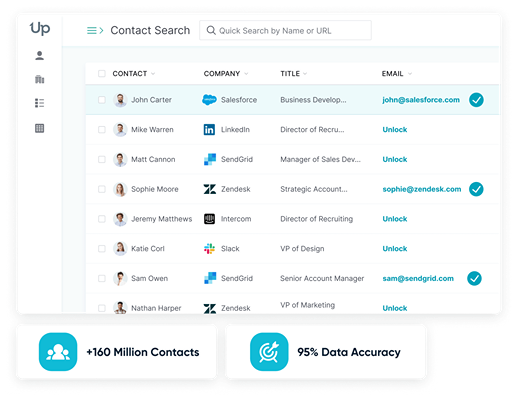
UpLead is a reliable B2B data provider that offers real-time verified buyer intent data to help businesses identify and connect with decision-makers actively searching for solutions. UpLead’s B2B intent data is collected from Bombora, the company that invented and pioneered this type of data. UpLead’s data is almost always correct (95%), making it one of the most reliable services of its kind.
If these features and advantages suit your needs, feel free to start your free trial at UpLead!
Key Features
- Company data from more than 190 countries
- CRM and API integrations
- Can be used for both contact and company information
- Numerous filters
Pros
- Relevant and accurate data
- Great ease of use
- Easy-to-use filtering
Cons
- As with any such solution, not 100% of data can be up-to-date at any given moment
2. ZoomInfo
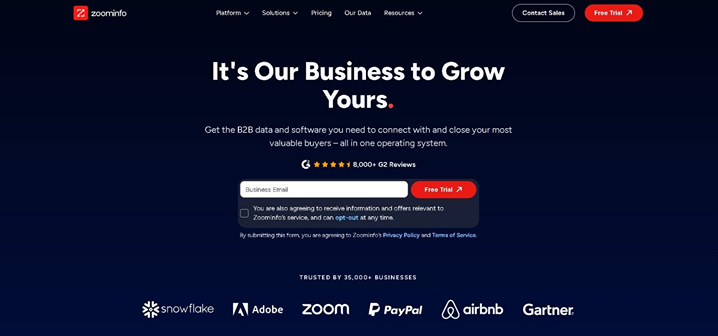
ZoomInfo is a B2B intelligence platform with information on over 50 million businesses. It provides comprehensive intent data that enables companies to engage with prospects at the right moment.
Key Features
- Company activity tracking
- Customizable alerts
- Great contact base
Pros
- Decent integration capabilities
- Has a browser extension
Cons
- Complex to use
- Some information isn’t updated
- Expensive to use
3. Bombora
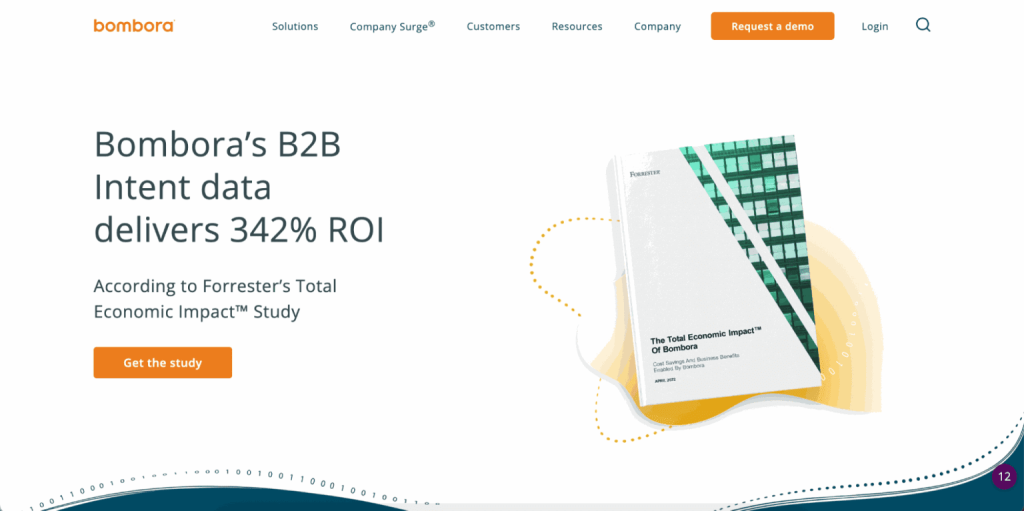
Bombora specializes in intent-based audience segmentation, helping businesses identify, delineate, and target high-intent accounts. It gathers third-party intent data from a vast network of B2B websites.
Key Features
- Collects behavioral intent signals from over 5,000+ B2B websites
- Audience segmentation features
- Integration with CRMs and marketing tools
- Focus on compliance
Pros
- Great segmentation features
- Can be integrated with a lot of tools
Cons
- Only focuses on intent data
- Lower data quality
A Closer Look at UpLead’s Buyer Intent Data
UpLead allows you to easily find prospects with relevant intent data. We offer a number of different topics by which you can find the businesses that you need.
To leverage intent data on our tool, go to the Company Search feature. Then, click Intent feature and type the relevant topics to select them.
For example, you can pick the topics that revolve around CRMs.
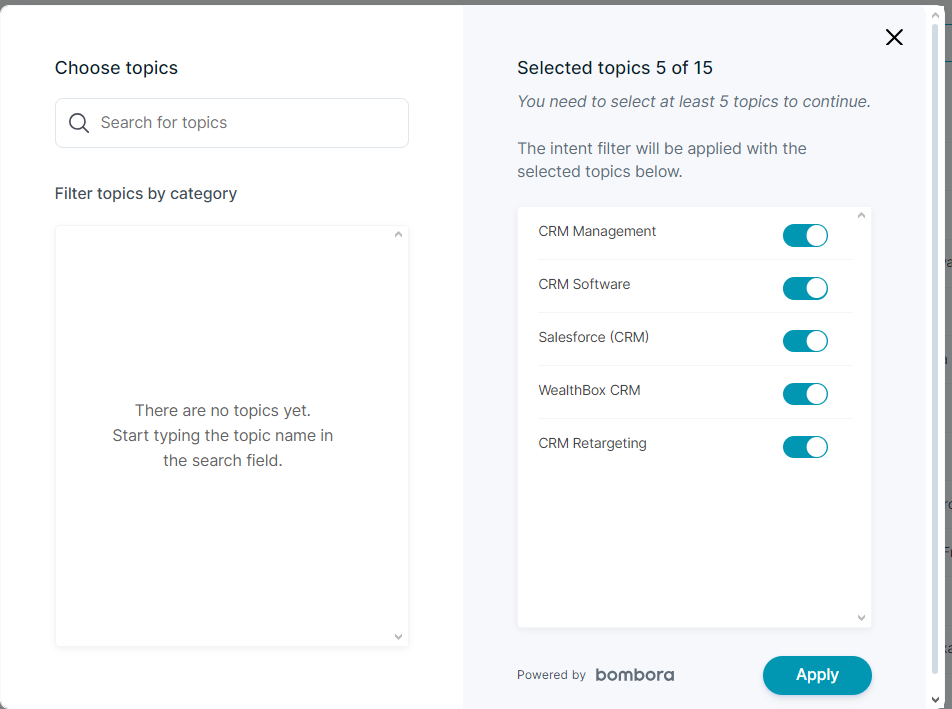
However, you don’t have to start the search until you’re confident in its scope. You can apply additional filters, such as the company’s size, industry, and location.
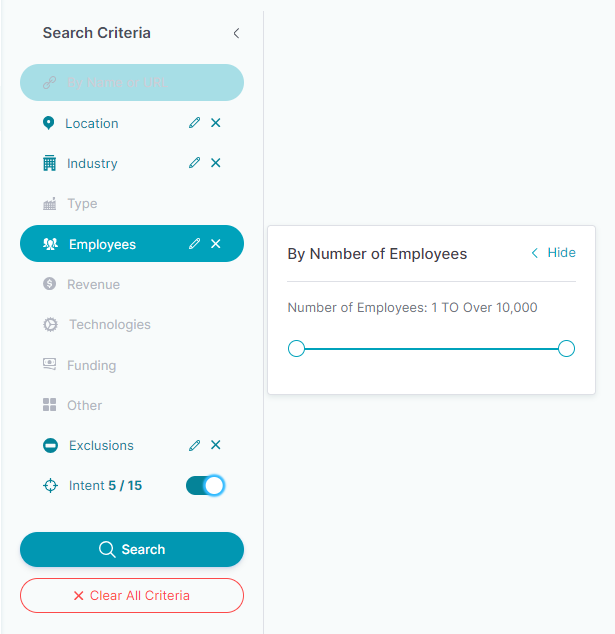
You’ll get a comprehensive list of results. At first glance, you’ll notice that you have all the essential information on the businesses, including their phone number and locations. Of course, you can dive deeper into any promising prospects.
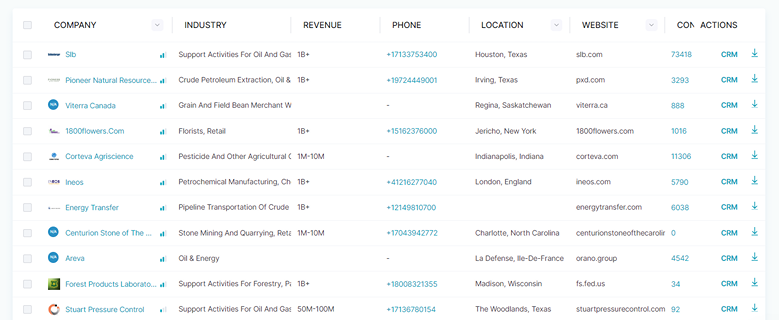
If something catches your attention, you can visit the company’s page and explore them further. UpLeads also has a feature that allows you to easily view prospects’ emails.
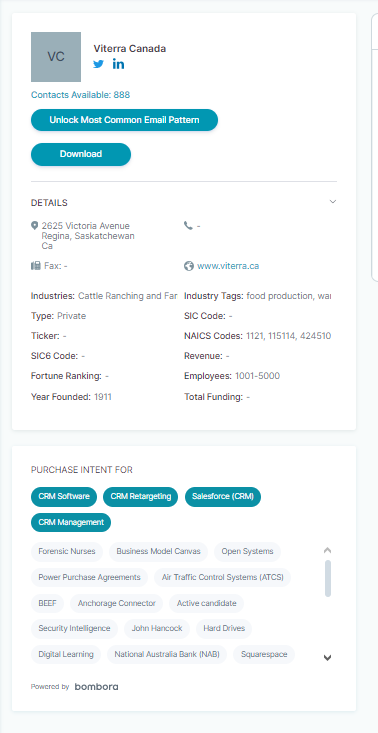
Besides the initially focused topics of your search, you can explore other areas in which this business intends to make purchases. UpLead provides you with buyers’ intent and high-quality data on technographics, firmographics, and employees.
After generating the list of companies according to your initial filters, simply click on the related filters that you want.
Best Practices for Using Intent Data
Your data is only as valuable as the manner in which you leverage it. Here are some of the best practices for using intent data:
- Align sales & marketing teams: Ensure both departments work closely to interpret and act on intent data effectively, providing them with centralized access to a data provider platform.
- Verify data accuracy: Trusted platforms like UpLead provide you with accurate data on your prospects. You can use them to verify the current information that you have on them. For example, suppose you have an outdated phone number or email address for a prospect. In that case, UpLead can help you confirm or update this information, ensuring your outreach is directed to the right contact.
- Use multi-channel targeting: Intent data can help you tailor strategies for all of your channels. Salespeople can make better pitches by understanding what prospects want, marketers can target campaigns based on prospects’ interests, and SEO specialists’ articles can answer the prospect’s questions—all based on their search intent.
- Focus on high-intent signals: Instead of contacting random leads en masse, preserve time, energy, and credits for tools by focusing on high-intent companies.
- Continuously optimize campaigns: For example, if you pitch to users who only read a blog post on your website without checking your tool, and you don’t get any results, you’ll know to avoid such prospects. Meanwhile, you can observe which activities led up to a sale, allowing you to know who to contact in the future.
FAQs About Buyer Intent Data
One example of intent data is when a business decision maker visits a company’s pricing page, explores its homepage, and downloads a whitepaper.
Based on behavioral signals, the buyer’s intent refers to the prospect’s likelihood of purchase.
You can collect first-party intent data from your website or purchase third-party intent data from providers like UpLead.
B2B data providers like UpLead, ZoomInfo, and Bombora sell intent data solutions.
Intent data is worth it, as it can help you with insights that provide sales efficiency, improve marketing ROI, and help businesses engage prospects at the right time.
What You Need to Remember About Buyer Intent Data
Buyer intent data is the key to understanding which prospects are worth contacting. It helps you focus on the businesses interested in your product and allows you to tailor your sales and marketing strategies. You can collect buyer intent data independently or rely on B2B data providers who do the heavy lifting.

